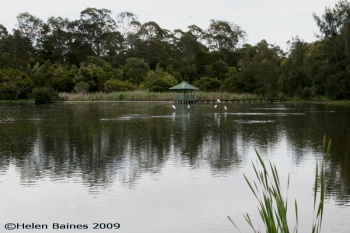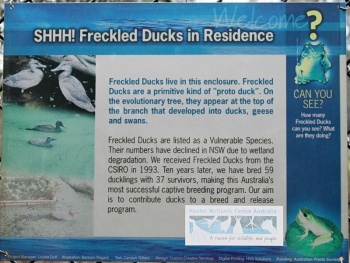| This article is incomplete. This article is missing one or more sections. You can help the BirdForum Opus by expanding it. |
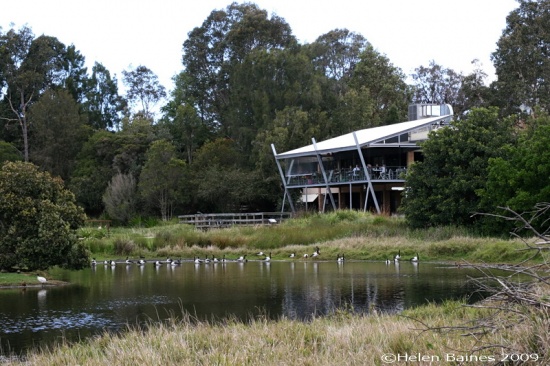
Hunter Wetlands Centre Australia, with Magpie Geese in the pond in front of the visitor centre, October 2009
Overview
The Hunter Wetlands Centre Australia (previously known as the Shortland Wetlands Centre) is located 10 minutes drive from Newcastle, 1.5 hours north of Sydney, New South Wales, Australia. This 45 hectare site was recognized as internationally important under the Ramsar Convention in 2002, and is also important for the conservation of 2 threatened species, the Freckled Duck and the Magpie Goose. 213 species of birds, in 49 families have been observed here.
Birds
Notable Species
The HWCA has important habitat for the Magpie Goose, a rare species in NSW. This species is found across northern Australia, including western NSW, south-east South Australia and southern and western Victoria. Habitat loss and hunting of the geese caused extirpation in the Hunter Valley, but small numbers of the geese returned, and the HWCA began a re-introduction program in 1987 and the first successful breeding in the wild was in 1992.
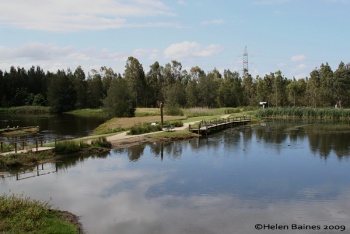
View from the Visitor Centre, showing BHP Billiton Pond and Brambles Pond (left), October 2009
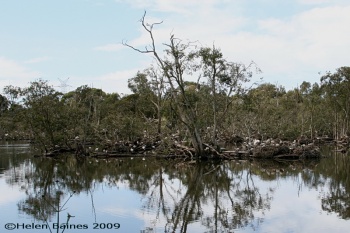
Egrets, herons, cormorants and the Australian Ibis breed in the heronry, October 2009
HWCA is also important as being one of only four centres in Australia, where there is a captive breeding program for the Freckled Duck, which is listed as Vulnerable in NSW.
Four species of egret: Great Egret, Intermediate Egret, Little Egret and Eastern Cattle Egret, are also important at HWCA and since 1985, they have been the focus of Project Egret Watch.
Rarities
Freckled Duck in captive breeding program and the Magpie Goose.
Check-list
Birds you can see here include:
"to do"
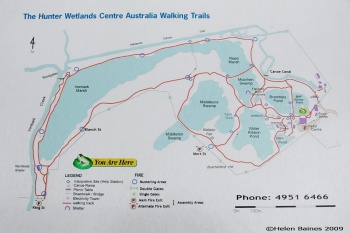
Walking trails map located on numerous signs around the reserve
Click on photo for a larger image
Other Wildlife
Out of nine mammal species recorded at HWCA, only 3 are native Australian: Grey Headed Flying Fox, Little Red Flying Fox and Northern Brown Bandicoot. It is thought that this is due to the fairly small size of HWCA (45ha), and its proximity to an urban environment which has been highly developed in the last 40 years. Other mammals as follows: Water Rat, House Mouse, Black Rat, Brown Hare, European Rabbit, Red Fox.
Site Information
History and Use
The Hunter Wetlands Centre Australia, located between the towns of Shortland and Waratah West, was originally part of a much larger wetland, the Hexham Swamp complex. Prior to the 1980s these wetlands were filled and variously used as a rubbish dump, soccer and rugby fields, and also for railway construction, leaving only a few remnant patches of swamp. Eventually the playing fields and buildings were abandoned as unviable.
In the early 1980s a biological education and research centre was developed to study the 4 species of egrets which had established a breeding colony in the remnant wetland. Then after proposals to fill the remaining wetland and further develop the area, some local concerned citizens formed the Hunter Wetlands Group to protect the area. This later became the Hunter Wetlands Trust. In 1985 the land was purchased in the name of Shortland Wetlands Centre Ltd, with donations from BHP, Newcastle City Council and the NSW Bicentennial Council. The big clean-up and reconstruction of the wetlands began, with the help of local volunteers.
Over the next few years, with funding from local businesses and service clubs, much work was done to improve the site - walking trails, observation tower, boardwalks, picnic shelters, etc. Greening Australia (Hunter Valley) and the Australian Plant Society planted thousands of native trees and plants throughout the site.
In 2002 the site was listed as internationally important under the Ramsar Convention. Then in 2005, after several name changes over the years, the centre's name became Hunter Wetlands Centre Australia. In 2009, HWCA received an Award of Distinction for Ecotourism in the Hunter Region Tourism Awards.
Areas of Interest
- Walking trails, boardwalks, egret tower, picnic shelters
- Freckled Duck enclosure
- Discovery Zone
- Guided Ecotours
- Ironbark Creek - canoe hire available
- Bird and reptile feeding ~ daily at 11am
Access and Facilities
- Visitor Centre ~ interpretative display area, theatrette, classroom, research library and café
Opening times:
- Wetlands Centre 9am-4pm daily
- Spoonbill Café 9am-3pm daily
- Closed Christmas Eve, Christmas Day, Boxing Day, New Years Eve, New Years Day, Good Friday and Easter Monday
Entrance fees:
- All tickets ~ Aus$5.00 (children over 5; under 3 free); Pre-schoolers (3-5 years) ~ Aus$2.00; School Holiday Special (5-12 years) ~ Aus$2.00; Family (2 adults + 2 children up to 12) ~ Aus$15.00
- Group entry (min 10 people) ~ Aus$4.00 each; Essential Carers assisting disabled visitors ~ FREE; HWCA members ~ FREE
Contact Details
Mailing address:
PO Box 292
Wallsend NSW 2287
Location:
Sandgate Road
Sandgate NSW 2304
Tel: 02 4951 6466
Content and images posted by HelenB





